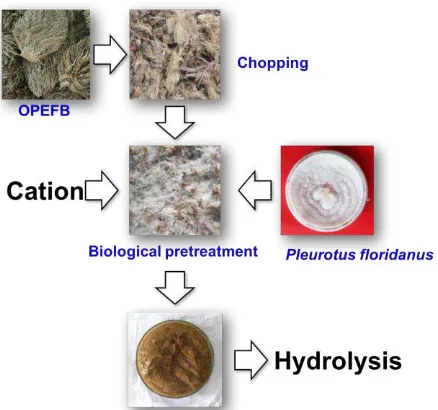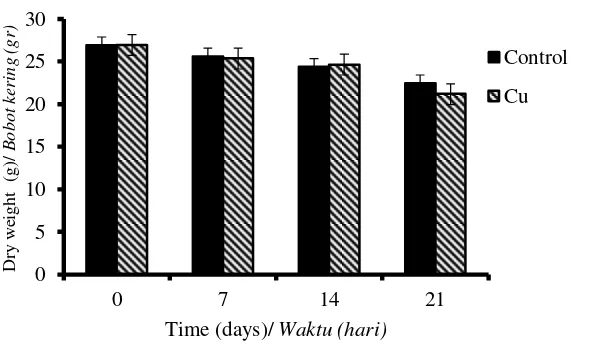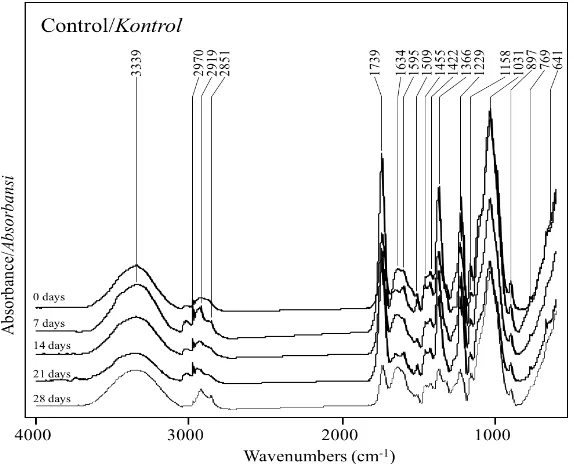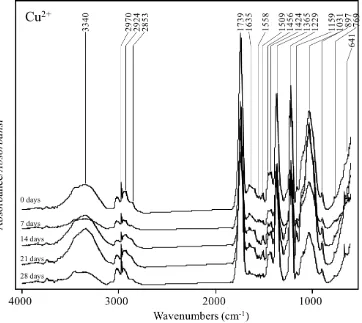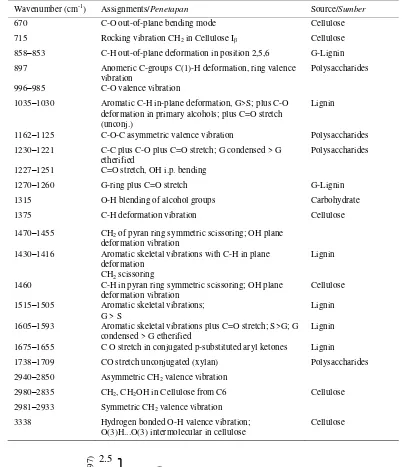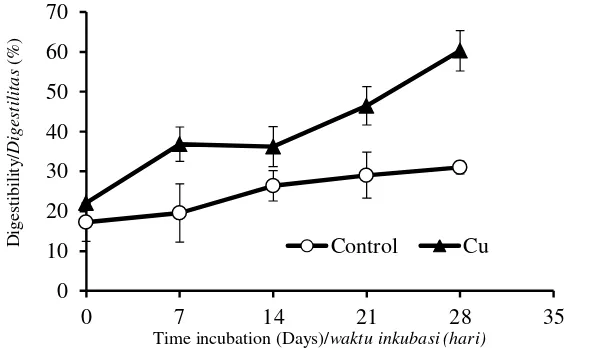Menara Perkebunan 2017, 85 (2), 67-76
p-ISSN: 0215-9318/ e-ISSN: 1858-3768 Accreditation Number: 588/AU3/P2MI-LIPI/03/2015
Characteristic of oil palm empty fruit bunch pretreated with Pleurotus
floridanus
Pretreatment biologi tandan kosong kelapa sawit menggunakan Pleurotus floridanus
ISROI*)
Indonesian Research for Biotechnology and Bioindustry, Taman Kencana Street No. 1 Bogor 16100, Indonesia.
Diterima tgl 3 Januari 2017 / disetujui tgl 3 September 2017
Abstrak
Pleurotus floridanus memiliki kemampuan untuk mendegradasi lignin dengan memproduksi enzim ligninolitik dan lebih memilih untuk
mendegradasi lignin daripada karbohidrat
(hemiselulosa dan selulosa). Kemampuan unik P.
floridanus ini dimanfaatkan dalam pretreatment biologi tandan kosong kelapa sawit. Penambahan
kation (Cu2+) pada pretreatment biologi
menurunkan kandungan lignin dan meningkatkan
digestibiliti tandan kosong kelapa sawit.
Perlakuan P. floridanus mengurangi kandungan
lignin dan hemiselulosa dari 23,9% menjadi 10,1% dan dari 20,8% menjadi 16,9%. Perlakuan
P. floridanus tidak menurunkan kandungan selulosa. Kandungan selulosa tandan kosong kelapa sawit meningkat dari 40,4% menjadi 51,7%. Kristalinitas tandan kosong menurun setelah pretreatment biologi. Kristalinitas yang dinyatakan dalam LOI (LOI, Lateral Order Index) adalah 2,08 untuk tandan kosong tanpa pretreatment biologi dan 1,44 untuk tandan kosong dengan pretreatment biologi. Digestibiliti itandan kosong meningkat dari 17,2% menjadi 60,3%.
[Kata kunci: Pretreatment biologi, tandan kosong
kelapa sawit, jamur pelapuk putih,
lignoselulosa, Pleurotus floridanus]
Abstract
Pleurotus floridanus have ability on lignin
degradation by producing ligninolytic enzyme and prefer to degrade lignin than carbohydrate (hemicellulose and cellulose). Oil palm empty fruit bunches has been pretreated using P.
floridanus. Addition of cation (Cu2+) on
biological pretreatment reduced lignin content and increased digestibility of the empty fruit bunches. P. floridanus reduce lignin and
hemicellulose content from 23.9% to 10.1% and from 20.8% to 16.9%, respectively. P. floridanus
did not degrade cellulose. Cellulose content of empty fruit bunches increase from 40.4% to 51.7%. Crystallinity of empty fruit bunches reduced after biological pretreatment. Crystallinity presented as LOI (lateral order
index) of un-treated and biological pretreated oil palm empty fruit bunches are 2.08 and 1.44. Digestibility of the empty fruit bunches increased from 17.2% to 60.3% by biological pretreatment.
[Key words: biological pretreatment, oil palm
empty fruit bunches, Pleurotus
floridanus, biofuel, white-rot
fungi, lignocellulose]
Introduction
Indonesia is the largest producer of crude palm oil (CPO) in the world. Indonesia produced 31 million metric tons of oil palm fruit in 2015 and accumulated 28.65 million metric tons of unused oil palm empty fruit bunches (OPEFB) (Dirjenbun, 2015). OPEFB is containing high lignocellulose and high polysaccharide. OPEFB provides enough potential sources of fermentable sugar for biological conversion and other lignocelluloses base derivate products (Abdulrazik et al., 2017; Piarpuzán et al., 2011).
OPEFB has a great potential as feedstock for production of value-added product, such as: xylitol, xylose, glucose, furfural, fuel, pulp, cellulose, microcrystalline cellulose and nano fiber cellulose (Fahma et al., 2010; Piarpuzán et al., 2011; Rahman et al., 2007; Wanrosli et al.,2011).
However, OPEFB has low digestibility. The enzymatic digestibility of lignocellulosic materials is limited by a number of factors such as lignin content and its composition, cellulose crystallinity, degree of polymerization, pore volume, acetyl groups bound to hemicellulose, surface area and biomass particle size (Ringkas, 2016; Zhu et al., 2008). The breakdown of the
lignin barrier is necessary since the lignin protects the cellulose from an enzyme attack by pretreatment technology, such as biological pretreatment that employs microorganism, such as white-rot fungi.
White-rot fungi are known as the most efficient microorganism in lignin degradation (Wong, 2009). Some species of the white-rot fungi selectively degrade lignin and hemicelluloses more than cellulose and
*)
Penulis korespondensi: isroi93@gmail.com.
ruminant feed, bioethanol and biogas (Adamovic
et al., 1998; Kinnunen et al., 2017; Nuraini &
Trisna, 2017; Taniguchi et al., 2010; Wyman et
al., 2017).
Biological pretreatment using white-rot fungi and/or combination with other pretreatment methods has been evaluated for bioethanol, biogas production and other chemical production from lignocellulose biomass (Hamisan et al.,
2009; Ma et al., 2010; Salvachúa et al., 2011; Yu
& Zhang, 2009; Yu et al., 2009). This results in
cellulose that is unprotected and easier to hydrolyze. This study relates to the effects of biological pretreatment of OPEFB using
Pleurotus floridanus under solid-state
fermentation. Dry weight loss, compositional, and structural changes of the OPEFB were discussed.
Material and Method (51% water content) was placed in a glass bottle and 30 ml of medium (contain 20 ppm of Cu2+) or distillate water for control was added. The bottles were autoclaved at 121°C for one hour.
Biological pretreatment of oil palm empty fruit bunches
P. floridanus cultured on PDA medium in
room temperature for at least one week. Fresh culture of P. floridanus was used for biological
pretreatment. The OPEFB were inoculated with eight pieces ( 10 mm2) of mycelia mats that
were cut from the plate cultures. Each culture (bottle) was incubated at 30°C for different periods of time, i.e., 0, 7, 14 and 21 days. At the end of the incubation period, the fungal biomass
as illustrated in Figure 2. The weight loss during every fractionation step gives the weight fraction of the major lignocellulose components: water-soluble, hemicelluloses, cellulose, and lignin. The dry weight was determined after drying the samples at 105±3°C for 24 hours, according to the standard test TAPPI T264 cm-97 (TAPPI Standards, 2007).
Enzymatic hydrolysis
Menara Perkebunan 2017, 85 (2), 67-76
Figure 1. General steps of biological pretreatment of oil palm empty fruit bunches using Pleurotus
floridanus.
Gambar 1. Langkah-langkah umum pretreatment biologi tandan kosong kelapa sawit menggunakan
Pleurotus floridanus.
Figure 2. Sequential fractionation of the lignocellulose component, slightly modified from the Chesson Datta methods.
Gambar 2. Fraksinasi sekuensial dari komponen lignoselulosa, modifikasi dari metode Chesson-Datta.
1 g samples refluxed for 2 h with 150 ml of H2O at 100°C
Dried residue refluxed for 2 h with 150 ml of 0.5 M H2SO4 at 100°C
Dried residue treated with 10 mL of 72% (v/v) H2SO4 at room temperature for 4 h, then diluted to 0.5 M H2SO4, and refluxed at
100oC for 2 h
Hot atersoluble
Hemicellulose
Cellulose
Lignin
Ash
The initial content of OPEFB is presented in Table 1. The biological pretreatment of the lignocellulosic materials degrades the solid components into less complex structures, water-soluble materials, and gaseous products. It is generally observed that biological pretreatment resulted in the reduction of the oven dry weight (ODW) of OPEFB (Figure 3). There are no significant different in reduction of ODW between control and Cu addition, but significant different found in the reduction of HWS, hemicellulose and lignin content. Biological pretreatment reduced all component of OPEFB except cellulose. Generally white-rot fungi has all enzyme machinery to degrade all lignocellulose components including Pleurotus spp (Cohen et al., 2002; Kuforiji & Fasidi, 2009;
Pedraza-Zapata et al., 2017; Wong, 2009). Most biological
pretreatment using white-rot fungi degraded all cellulose component in various amount (Hongbo
Yu et al., 2009; Zhang et al., 2017). P. floridanus
used in this research has unique ability to selectively degrade lignin and hemicellulose than cellulose. Biological pretreatment by P.
Structural changes and crystallinity of the oil palm empty fruit bunches
Biological pretreatment altered the physical characteristics of the OPEFB, by turning its color from dark brown to a lighter color, and it became more brittle and easier to grind. The color change may be used as an initial indication of the lignin reduction or removal.
Table 1. Initial lignocelluloses content of the oil palm empty fruit bunches.
Tabel 1. Kandungan lingoselulosa awal tandan kosong kelapa sawit. Hot water soluble/komponen larut air panas 14.47±0.0004
Ash/abu 1.219±0.0056
Figure 3. Decrease of the dry weight (ODW) of the OPEFB during the pretreatment using P. floridanus: Control (without cation) and Cu (addition of Cu2+).
Menara Perkebunan 2017, 85 (2), 67-76
Figure 4. Changes in the OPEFB components of (a) hot water soluble (HWS), (b) hemicellulose, (c) cellulose,
and (d) lignin during the biological pretreatment using P. floridanus: Control (without cation) and Cu
(addition of Cu2+).
Gambar 4. Perubahan komponen tandan kosong kelapa sawit (a) komponen larut air panas (HWS, hot water soluble), (b) hemiselulosa, (c) selulosa, dan (d) lignin selama pretreatment biologi menggunakan P. floridanus: kontrol (tanpa penambahan kation) dan Cu (penambahan Cu2+
).
Figure 5. FTIR spectra of the biologically pretreated OPEFB without the cation addition for 0, 7,
14 and 21 days.
Gambar 5. Spektra FTIR dari TKKS yang sudah dipretreatment biologi tanpa penambahan kation selama 0, 7, 14 dan 21 hari.
The structural changes of the materials were analyzed using the FTIR, which reflects the changes in the functional groups of the OPEFB. The peaks of the IR Spectrum at certain wavelengths could be lower, higher, and/or shifted, which indicates the alteration of certain functional groups associated with that wavelength. The intensities of the C=O stretch in the un-conjugated ketone, carbonyl, and ester groups at wavenumbers 1739–1738 cm-1, mainly
The digestibility compares the sugar produced from the hydrolysis of the pretreated OPEFB with that of the untreated one. Its reveals that the digestibility of all the pretreated OPEFB increases as the time of the incubation increased (Figure 8). Un-pretreated OPEFB has very low
acetyl groups bound to surface area and biomass particle size (Alvira, et al., 2010). In this study,
increasing of the OPEFB digestibility has significant correlation with reduction in lignin and hemicellulose content, and increasing the cellulose content.
Figure 6.FTIR spectra of the biologically pretreated OPEFB with the Cu2+ addition for 0, 7, 14 and 21 days. Gambar 6. Spektra FTIR dari TKKS yang sudah dipretreatment biologi dengan penambahan Cu2+ selama 0, 7,
14 dan 21 hari.
Menara Perkebunan 2017, 85 (2), 67-76
Table 2. Assignment of the FTIR-Absorption Bands (cm-1) to various components of the oil palm empty fruit bunches according to existing literature (Isroi et al., 2012).
Tabel 2. Penetapan pita absorbs FTIR (cm-1) ke dalam berbagai komponen tandan kosong kelapa sawit berdasarkan literature (Isroi et al., 2012).
Wavenumber (cm-1) Assignments/Penetapan Source/Sumber
670 C-O out-of-plane bending mode Cellulose
715 Rocking vibration CH2 in Cellulose Iβ Cellulose 858–853 C-H out-of-plane deformation in position 2,5,6 G-Lignin 897 Anomeric C-groups C(1)-H deformation, ring valence
vibration
Polysaccharides
996–985 C-O valence vibration
1035–1030 Aromatic C-H in-plane deformation, G>S; plus C-O deformation in primary alcohols; plus C=O stretch (unconj.)
Lignin
1162–1125 C-O-C asymmetric valence vibration Polysaccharides 1230–1221 C-C plus C-O plus C=O stretch; G condensed > G
etherified Polysaccharides
1227–1251 C=O stretch, OH i.p. bending
1270–1260 G-ring plus C=O stretch G-Lignin
1315 O-H blending of alcohol groups Carbohydrate
1375 C-H deformation vibration Cellulose
1470–1455 CH2 of pyran ring symmetric scissoring; OH plane deformation vibration
1430–1416 Aromatic skeletal vibrations with C-H in plane deformation
CH2 scissoring
Lignin
1460 C-H in pyran ring symmetric scissoring; OH plane
deformation vibration Cellulose
1515–1505 Aromatic skeletal vibrations;
G > S Lignin
1605–1593 Aromatic skeletal vibrations plus C=O stretch; S>G; G condensed > G etherified
Lignin
1675–1655 C O stretch in conjugated p-substituted aryl ketones Lignin
1738–1709 CO stretch unconjugated (xylan) Polysaccharides 2940–2850 Asymmetric CH2 valence vibration
2980–2835 CH2, CH2OH in Cellulose from C6 Cellulose 2981–2933 Symmetric CH2 valence vibration
3338 Hydrogen bonded O-H valence vibration; O(3)H...O(3) intermolecular in cellulose
Cellulose
Figure 8. Hydrolysis yield of the OPEFB samples biologically pretreated using P. floridanus without the cation addition (control) and with Cu2+ addition.
Gambar 8. Hasil hidrolisis contoh TKKS yang sudah dipretretment menggunakan P. floridanus tanpa penambahan kation (kontrol) dan penambahan Cu2+.
Conclusion
The P. floridanus used in the biological
pretreatment of the OPEFB selectively degrades the lignin, hemicelluloses, and HWS, but not the cellulose. There is no correlation between the cellulose degradation and the dry weight loss, which implies that the fungi used in this work does not degrade the cellulose. The analysis of the FTIR spectra reveals significant changes in the OPEFB in its functional group in various regions, mainly the lignin and hemicellulose. Although there was no significant degradation of the cellulose, structural changes in the cellulose were observed using the FTIR spectra and could imply a reduction in the crystallinity. The degradation of the lignin and the hemicellulose may contribute to the improvement of the OPEFB digestibility.
References
Abdulrazik A, M Elsholkami, A Elkamel & L Simon (2017). Multi-products produc-tions from Malaysian oil palm empty fruit bunch (EFB): analyzing economic potentials from the optimal biomass supply chain. Journal
of Cleaner Production168, 131–148.
Adamovic M, Grubic G., Milenkovic, I., Jovanovic, R., Protic, R., Sretenovic, L. & Stoicevic L (1998). The biodegradation of wheat straw by Pleurotus ostreatus
mushrooms and its use in cattle feeding.
Animal Feed Science and Technology,
71(3–4), 357–362.
Åkerholm M., Hinterstoisser, B & Salmén L. (2004). Characterization of the crystalline structure of cellulose using static and dynamic FT-IR spectroscopy. Carbohydrate
Research, 339(3), 569–578.
Alvira, P, Tomas-Pejo E., Ballesteros M. & Negro M J (2010). Pretreatment technologies for an efficient bioethanol production process based on enzymatic hydrolysis: A review.
Bioresource Technology 101(13), 4851–
4861.
Balogun A O, Lasode O A & McDonald A G (2016). Thermo-physical, chemical and structural modifications in torrefied biomass residues. Waste and Biomass Valorization,
1–8.
Chundawat S P S, Balan V & Dale B E (2008). High-throughput microplate technique for enzymatic hydrolysis of lignocellulosic biomass. Biotechnol Bioeng 99(6), 1281–
1294.
Cohen R, Persky L & Hadar Y (2002). Biotechnological applications and potential of wood-degrading mushrooms of the genus Pleurotus. Appl Microbiol Biotechnol,
58(5), 582–594.
Dirjenbun (2015). Statistik Perkebunan
Indonesia: Kelapa sawit 2014-2015. Tree
Crop Estate Statistics of Indonesia
2014-2016.
Fahma, F Iwamoto, S Hori, N Iwata T & Takemura A (2010). Isolation, preparation, and characterization of nanofibers from oil palm empty-fruit-bunch (OPEFB).
Cellulose, 17(5), 977–985.
Menara Perkebunan 2017, 85 (2), 67-76
ostreatus grown on wood sawdust. Archives
of Biochemistry and Biophysics 376(1),
171–179.
Glazunova O A, Polyakov K M, Fedorova T V, Dorovatovskii P V & Koroleva O V (2015). Elucidation of the crystal structure of
Coriolopsis caperata laccase: restoration of
the structure and activity of the native enzyme from the T2-depleted form by copper ions. Acta Crystallographica Section
D: Biological Crystallography 71(4), 854–
861.
Hamisan A F, Abd-Aziz S, Kamaruddin K, Shah U K M, Shahab N & Hassan M A (2009). Delignification of oil palm empty fruit bunches using chemical and microbial pretreatment methods. International
Journal of Agricultural Research, p. 1–7.
Hamzah F, Idris A & Shuan T K (2011). Preliminary study on enzymatic hydrolysis of treated oil palm (Elaeis) empty fruit bunches fibre (EFB) by using combination
of cellulase and β 1-4 glucosidase. Biomass
and Bioenergy, 35(3), 1055–1059.
Isroi, Ishola M M, Millati R, Syamsiah S, Cahyanto M N, Niklasson C & Taherzadeh M J (2012). Structural changes of oil palm empty fruit bunch (OPEFB) after fungal and phosphoric acid pretreatment. Molecules 17(12), 14995–15002.
Kinnunen A, Maijala P, JArvinen P & Hatakka A (2017). Improved efficiency in screening for lignin-modifying peroxidases and laccases of basidiomycetes. Current
Biotechnology6(2), 105–115.
Kuforiji O O, & Fasidi I O (2009). Biodegradation of agro-industrial wastes by a edible mushroom Pleurotus tuber-regium
(Fr.). J Environ Biol30(3), 355–358.
Liquid P W I (2010). Structural changes evidenced by ftir pre-treatment with ionic liquid and enzymatic. Structure6, 400–413.
Ma F, Yang N, Xu C, Yu H, Wu J & Zhang X (2010). Combination of biological pretreatment with mild acid pretreatment for enzymatic hydrolysis and ethanol production from water hyacinth.
Bioresource Technology 101(24), 9600–
9604.
Martínez A T, Camarero S., Guillén F, Gutiérrez A, Muñoz C, Varela E, Pelayo J (1994). Progress in biopulping of non-woody materials: Chemical, enzymatic and ultrastructural aspects of wheat straw delignification with ligninolytic fungi from the genus Pleurotus. FEMS Microbiology
Reviews13(2–3), 265–273.
Nuraini A D & Trisna A (2017). Research article
Lignocellulolytic fungi as poultry diet.
International Journal of Poultry Science,
16(1), 6–10.
Pedraza-Zapata D C, Sánchez-Garibello A M, Quevedo-Hidalgo B, Moreno-Sarmiento N & Gutiérrez-Rojas I (2017). Promising cellulolytic fungi isolates for rice straw degradation. Journal of Microbiology, 55(9), 711–719. of the X-ray-induced enzymatic reduction of molecular oxygen to water by Steccherinum murashkinskyi laccase: insights into the reaction mechanism. Acta Crystallographica Section D: Structural
Biology73(5), 388–401.
Rahman S H A, Choudhury J P, Ahmad A L & Kamaruddin A H (2007). Optimization studies on acid hydrolysis of oil palm empty fruit bunch fiber for production of xylose.
Bioresource Technology, 98(3), 554–559.
Ringkas G (2016). The effect of various pretreatment methods on empty fruit bunch for glucose production. Malaysian Journal
of Analytical Sciences, 20(6), 1474–1480.
Salvachúa D, Prieto A, López-Abelairas M, Lu-Chau T, Martínez Á T & Martínez M J (2011). Fungal pretreatment: An alternative in second-generation ethanol from wheat straw. Bioresource Technology, 102(16),
7500–7506.
Takahashi N & Koshijima T (1988). Ester linkages between lignin and glucuronoxylan in a lignin-carbohydrate complex from beech (Fagus crenata) wood. Wood Science
and Technology, 22(3), 231–241.
Taniguchi M, Takahashi D, Watanabe D, Sakai K, Hoshino K, Kouya T & Tanaka T (2010). Effect of steam explosion pretreatment on treatment with Pleurotus
ostreatus for the enzymatic hydrolysis of Carreon L (2011). Increasing Pleurotus
ostreatus laccase production by culture
medium optimization and copper/lignin synergistic induction. Journal of Industrial
Wyman V, Henriquez J, Palma C, & Carvajal A (2017). Lignocellulosic waste valorisation strategy through enzyme and biogas production. Bioresource Technology, (in
Press), Available online 8 September 2017.
http://doi.org/10.1016/j.biortech.2017 .09.055
Yu H, Guo G, Zhang X, Yan K & Xu C (2009). The effect of biological pretreatment with the selective white-rot fungus Echinodontium taxodii on enzymatic
Biological pretreatment of soft-wood Larix kaempferi using three white-rot
fungi-Corticium caeruleum, Heterobasidion
insulare and Pseudotrametes gibbosa.
Fresenius Environmental Bulletin, 26(3),
1959–1966.
Zhu ., O’Dwyer J, Chang V S, Granda C B & Holtzapple M. (2008). Structural features affecting biomass enzymatic digestibility.
